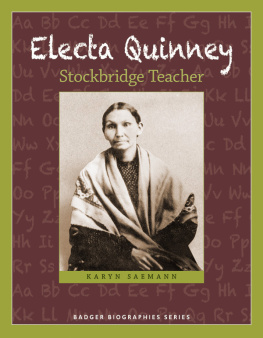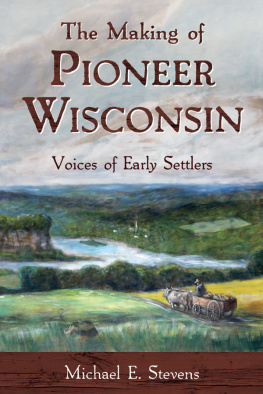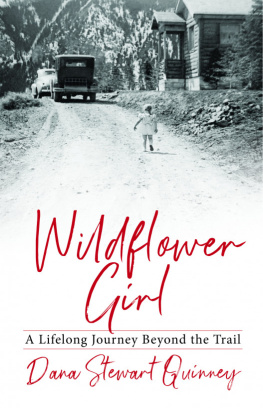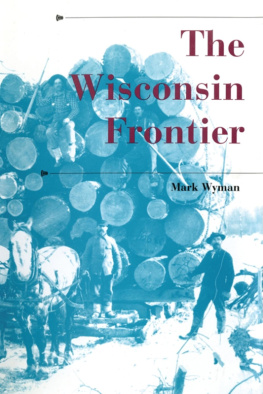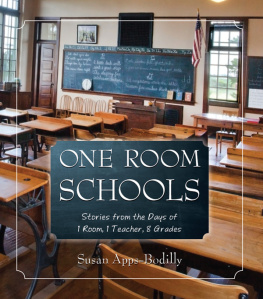Electa Quinney

Badger Biographies
Belle and Bob La Follette: Partners in Politics
Blue Jenkins: Working for Workers
Caroline Quarlls and the Underground Railroad
Casper Jaggi: Master Swiss Cheese Maker
Cindy Bentley: Spirit of a Champion
Cordelia Harvey: Civil War Angel
Cris Plata: From Fields to Stage/Del Campo al Escenario
Curly Lambeau: Building the Green Bay Packers
Dr. Kate: Angel on Snowshoes
Father Groppi: Marching for Civil Rights
Frank Lloyd Wright and His New American Architecture
Gaylord Nelson: A Champion for Our Earth
Harley and the Davidsons: Motorcycle Legends
Joyce Westerman: Baseball Hero
Les Paul: Guitar Wizard
Lucius Fairchild: Civil War Hero
Mai Yas Long Journey
Mary Nohl: A Lifetime in Art
Mountain Wolf Woman: A Ho-Chunk Girlhood
Ole Evinrude and His Outboard Motor
A Recipe for Success: Lizzie Kander and Her Cookbook
Richard Bong: World War II Flying Ace
Tents, Tigers, and the Ringling Brothers
Electa Quinney
Stockbridge Teacher
KARYN SAEMANN
WISCONSIN HISTORICAL SOCIETY PRESS
Published by the Wisconsin Historical Society Press
Publishers since 1855
2014 by the State Historical Society of Wisconsin
E-book edition 2014
For permission to reuse material from Electa Quinney: Stockbridge Teacher (ISBN 978-0-87020-641-2, e-book ISBN 978-0-87020-642-9), please access www.copyright.com or contact the Copyright Clearance Center, Inc. (CCC), 222 Rosewood Drive, Danvers, MA 01923, 978-750-8400. CCC is a not-for-profit organization that provides licenses and registration for a variety of users.
wisconsin history .org
Photographs identified with WHi are from the Societys collections; address requests to reproduce these photos to the Visual Materials Archivist at the Wisconsin Historical Society, 816 State Street, Madison, WI 53706.
Front cover: Photograph courtesy of the National Museum of the American Indian
Cover and interior design by Jill Bremigan
Interior page composition by Biner Design
18 17 16 15 14 1 2 3 4 5
The Library of Congress has cataloged the printed edition as follows:
Saemann, Karyn.
Electa Quinney : Stockbridge teacher / Karyn Saemann.
p. cm. (Badger biographies)
Includes bibliographical references and index.
ISBN 978-0-87020-641-2 (pbk.) ISBN 978-0-87020-642-9 (ebook) 1. Quinney, Electa, 1807-1882. 2. Stockbridge IndiansWisconsinBiography. 3. Indian women teachersWisconsin Biography. I. Title.
E99.S8.Q85S34 2014
305.8973449092dc23
[B]
2013036971

Publication of this book was made possible in part by a grant from the D.C. Everest fellowship fund.

Contents

1
Meet Electa Quinney

In 1828, a smart young woman named Electa Quinney did something very important in Wisconsin history. She became the states first public schoolteacher.
At that time, there were only a few towns in Wisconsin. Rough dirt roads and winding rivers carried travelers through thick forests and swamps. In towns in the woods, there were just a handful of schools. Most of the teachers were men.
Electa Quinney was different. She was a young woman who was a schoolteacher. What made her even more different was that she was a Stockbridge Indian.
Many Wisconsin Indians in 1828 had a had taught many of them about Christianity, but most Wisconsin Indians kept the religion that they had grown up with.
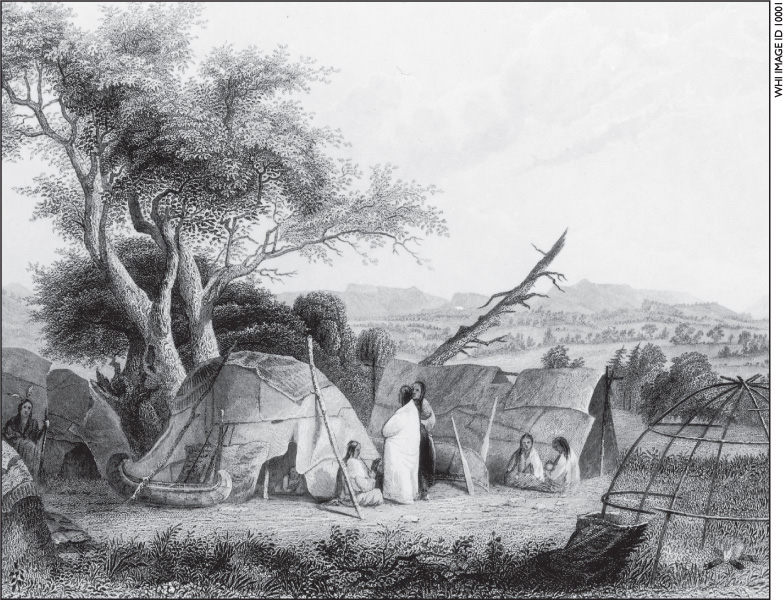
Wigwams
The Stockbridge Indians were different. They moved to Wisconsin from New York in the 1820s. When they arrived, the Stockbridge built homes made of logs. They grew crops and raised animals on farms. Women spun wool, knitted, and sewed clothes from cloth. Many of them spoke English and went to church.
Like many other Stockbridge Indians, Electa went to when she was young. She learned to speak and write English well. This made her an excellent schoolteacher.
There are many things we dont know about Electa. We dont know exactly when or where she was born, though it was somewhere in the state of New York. We dont know what she looked like when she was young. We have only one photo of Electa. It was taken in the 1860s, around the time when she became a grandmother. And there are a few times in Electas life when were not sure where she was living or what she was doing. She left behind no diary or other written memories.
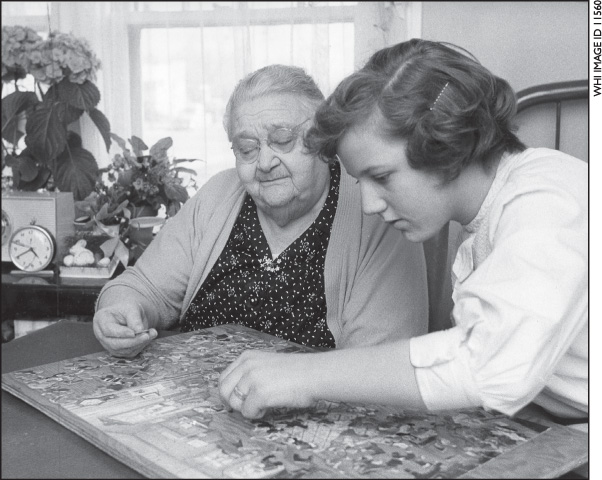
Understanding Electas life is like working on a jigsaw puzzle.
Understanding Electas life is like working on a jigsaw puzzle. We need to fit together many little pieces from many different places. Some of the puzzle pieces of Electas story are missing, so we have an incomplete picture of her life.
Some of what we know about Electa is found in letters written by her friends and family. Other people who knew Electa wrote down thoughts and memories about her. papers she signed, and a letter she wrote for older Stockbridge Indians who could not write in English.
We are certain about some things. We know that soon after she arrived in Wisconsin, Electa taught at a school in an Indian village called Statesburg. Electas school was made of logs, and it was surrounded by thick woods. Her students studied many of the same subjects children learn about today, such as math, spelling, and geography.
We know that Electa was a good teacher. She had many friends and she loved to read. Visitors to her home said that it was filled with books and that they enjoyed talking to her.
Sometimes Electa had to make difficult choices. Once, she made a tough decision to move to , near what would later become the state of Oklahoma. A few years after that, Electa said good-bye to her friends there and moved back to Wisconsin.
. If they became citizens, Stockbridge and Munsee Indians would no longer be members of their own tribe. What did Electa choose? The answer tells us a lot about Electa and a lot about the Stockbridge Indians.
2
New York Childhood

Electa was born around 1807 in the state of New York. She was probably born in New Stockbridge, an Indian village in the middle of the state. Many lakes and streams and good farmland surrounded the village. When the Stockbridge Indians chose their new home in Wisconsin in the 1820s, they picked a place that reminded them of New Stockbridge.
By the time Electa was born, most Stockbridge Indians lived differently than their many parts of European culture. Missionaries who visited the tribe in New Stockbridge in 1796 said men were raising sheep and crops on farms. Stockbridge women were spinning wool to sell. The tribe had a sawmill and a school, and they were planning to build a blacksmith shop.

